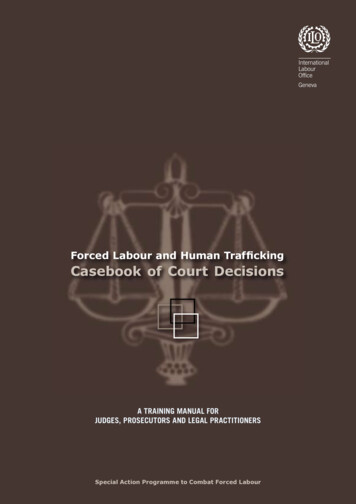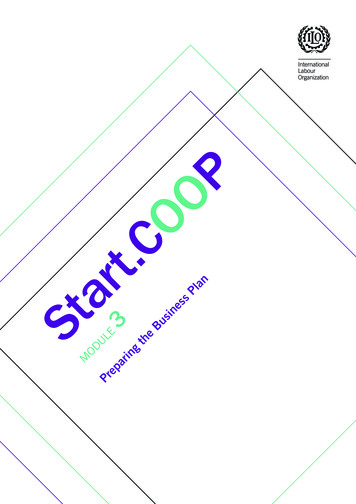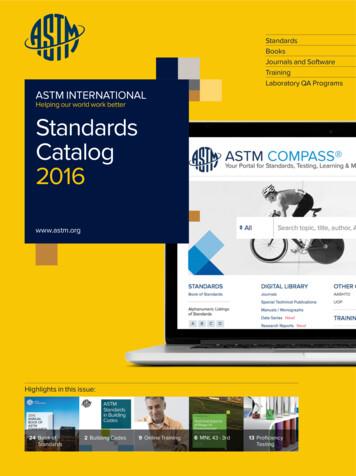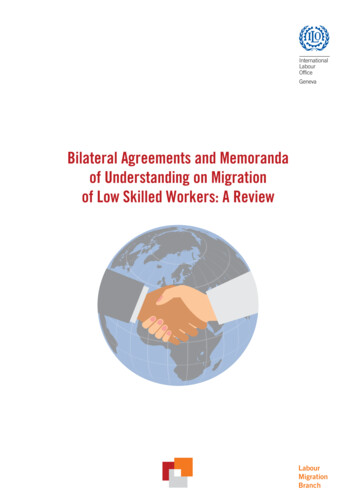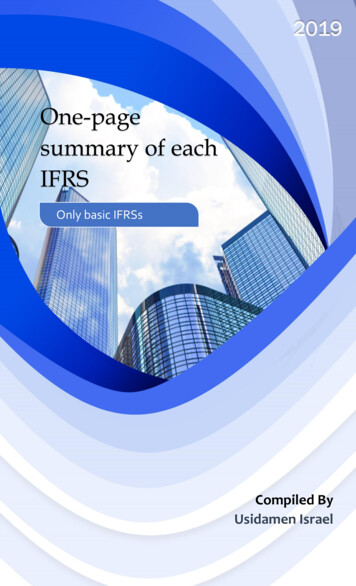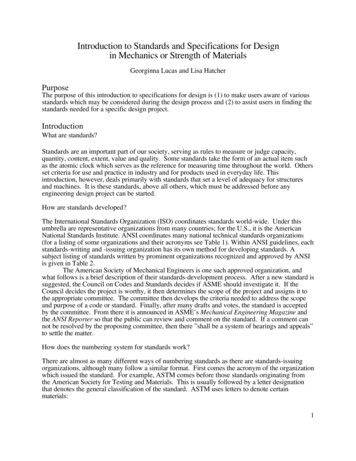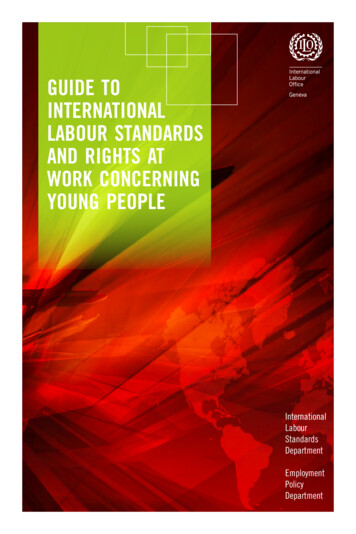
Transcription
guide tointernationallabour standardsand rights atwork concerningyoung mentPolicyDepartment
Guide to International LabourStandards and Rights at Workconcerning Young PeopleINTERNATIONALLABOUR STANDARDSDEPARTMENTEMPLOYMENTPOLICYDEPARTMENT
Copyright International Labour Organization 2017First published 2017Publications of the International Labour Office enjoy copyright under Protocol 2 of the UniversalCopyright Convention. Nevertheless, short excerpts from them may be reproduced without authorization, on condition that the source is indicated. For rights of reproduction or translation,application should be made to ILO Publications (Rights and Licensing), International LabourOffice, CH-1211 Geneva 22, Switzerland, or by email: rights@ilo.org. The International LabourOffice welcomes such applications.Libraries, institutions and other users registered with a reproduction rights organization may makecopies in accordance with the licences issued to them for this purpose. Visit www.ifrro.org to findthe reproduction rights organization in your country.Guide to international labour standards and rights at work concerning young people /International Labour Office, International Labour Standards Department, Employment PolicyDepartment. – Geneva: ILO, 2017.ISBN 978-92-2-130838-6 (print)ISBN 978-92-2-130839-3 (web pdf)International Labour Office. International Labour Standards Department;International Labour Office. Employment Policy Dept.youth employment / young worker / workers rights / ILO Convention / application /working conditions13.01.3ILO Cataloguing in Publication DataThe designations employed in ILO publications, which are in conformity with United Nationspractice, and the presentation of material therein do not imply the expression of any opinion whatsoever on the part of the International Labour Office concerning the legal status of any country,area or territory or of its authorities, or concerning the delimitation of its frontiers.The responsibility for opinions expressed in signed articles, studies and other contributions restssolely with their authors, and publication does not constitute an endorsement by the InternationalLabour Office of the opinions expressed in them.Reference to names of firms and commercial products and processes does not imply their endorsement by the International Labour Office, and any failure to mention a particular firm, commercialproduct or process is not a sign of disapproval.ILO publications and digital products can be obtained through major booksellers and digital distribution platforms, or ordered directly from ilo@turpin-distribution.com. For more information,visit our website: www.ilo.org/publns or contact ilopubs@ilo.org.This publication was produced by the Document and Publications Production,Printing and Distribution Branch (PRODOC) of the ILO.Graphic and typographic design, layout and composition,printing, electronic publishing and distribution.PRODOC endeavours to use paper sourced from forests managedin an environmentally sustainable and socially responsible manner.Code: DTP-WEI-REPRO
PrefaceEnsuring full and productive employment and decent work for all is centralto the ILO’s mandate and is embodied in Sustainable Development Goal 8of the 2030 Agenda for Sustainable Development. The achievement of thisglobal objective necessarily involves improved youth employment prospects,as young people are disproportionately affected by decent work deficits, unemployment and low-quality jobs.The resolution and conclusions concerning “The youth employment crisis:A call for action”, adopted by the International Labour Conference in 2012,underlined the urgent need for immediate and targeted measures to tacklethe unprecedented youth employment crisis that is affecting most countriesworldwide. The Call for Action provides guiding principles to support actionon youth employment: it advocates a multi-pronged approach to fosteringpro-employment growth and the creation of decent jobs trough macroeconomic policies, education, employability, labour market policies, and the promotion of youth entrepreneurship and self-employment and labour rights foryoung people.As stressed in the Call for Action, “Tackling youth unemployment shouldnot disregard and weaken the protection to which young workers are entitled.Reflecting the universal strong support to core international labour standards, policies facilitating access to jobs should not lead to discriminationat work Youth employment policies should also encourage the transitionfrom temporary to more stable jobs.”In this respect, social dialogue at the national level is instrumental in developing normative and policy frameworks that offer protection to all youngworkers; at the same time, adequate practices, supervision, and monitoringand evaluation systems must be in place for the relevant norms to be effectively applied and monitored.International labour standards are essential to protect the rights of youngworkers. While covering different thematic areas, this Guide focuses on thekey provisions of Conventions and Recommendations, in particular thoseof special relevance to young people, based on the 2012 Call for Action. Ittouches on specific labour-related problems affecting youth which have beenraised in the context of the application of international labour standards.Examples of good practices at the country and regional level are included.3
Guide to International Labour Standards and Rights at Work concerning Young PeopleThis Guide is intended for ILO constituents and other stakeholders concerned with promoting youth employment, and in particular ensuring decentwork for young people. It is also aimed at ILO staff and project managersengaged in youth employment initiatives at country level. For young peopleit provides the necessary information on their rights at work, as a relevantcomplement to the ILO’s “Rights@Work for Youth” toolkit.It is hoped that users will find this Guide to be a useful reference for thedevelopment and implementation of policies and measures aimed at enhancing labour market outcomes for young women and men worldwide.Corinne VarghaAzita Berar AwadDirectorInternational Labour Standards DepartmentDirectorEmployment Policy Department4
Table of contentsPreface . . . . . . . . . . . . . . . . . . . . . . . . . . . . . . . . . . . . . . . . . . . . . . . . . . . . . .3Acknowledgements . . . . . . . . . . . . . . . . . . . . . . . . . . . . . . . . . . . . . . . . . . . .71. Introduction. . . . . . . . . . . . . . . . . . . . . . . . . . . . . . . . . . . . . . . . . . . . . . . .91.1 Purpose and structure of the Guide. . . . . . . . . . . . . . . . . . . . . . . . . 111.2 Definitions . . . . . . . . . . . . . . . . . . . . . . . . . . . . . . . . . . . . . . . . . . . . .(a) Young persons. . . . . . . . . . . . . . . . . . . . . . . . . . . . . . . . . . . . . . . .(b) International labour standards. . . . . . . . . . . . . . . . . . . . . . . . . . .(c) The social partners. . . . . . . . . . . . . . . . . . . . . . . . . . . . . . . . . . . .(d) ILO supervisory system . . . . . . . . . . . . . . . . . . . . . . . . . . . . . . . .2. General framework of international labour standardsapplicable to young persons. . . . . . . . . . . . . . . . . . . . . . . . . . . . . . . . . . . .1212121314172.1 Fundamental Conventions and related instruments. . . . . . . . . . . .(a) Freedom of association. . . . . . . . . . . . . . . . . . . . . . . . . . . . . . . . .(b) Collective bargaining . . . . . . . . . . . . . . . . . . . . . . . . . . . . . . . . . .(c) Protection of workers’ representatives. . . . . . . . . . . . . . . . . . . . .(d) The elimination of all forms of forced and compulsory labour . .(e) The elimination of child labour and the protectionof children and young persons . . . . . . . . . . . . . . . . . . . . . . . . . . .(f) Equality and non-discrimination in employment and occupation. .(g) Equal remuneration for men and womenfor work of equal value. . . . . . . . . . . . . . . . . . . . . . . . . . . . . . . . .1717202122302.2 Governance Conventions and employment instruments. . . . . . . . .(a) Employment policy. . . . . . . . . . . . . . . . . . . . . . . . . . . . . . . . . . . .(b) Job creation in small and medium-sized enterprises . . . . . . . . . .(c) Cooperatives. . . . . . . . . . . . . . . . . . . . . . . . . . . . . . . . . . . . . . . . .(d) Vocational guidance and vocational training. . . . . . . . . . . . . . . .(e) Employment services. . . . . . . . . . . . . . . . . . . . . . . . . . . . . . . . . . .(f) Labour administration and inspection. . . . . . . . . . . . . . . . . . . . .3132353636374224275
Guide to International Labour Standards and Rights at Work concerning Young People2.3 Technical Conventions. . . . . . . . . . . . . . . . . . . . . . . . . . . . . . . . . . . .(a) Wages. . . . . . . . . . . . . . . . . . . . . . . . . . . . . . . . . . . . . . . . . . . . . .(b) Employment relationship . . . . . . . . . . . . . . . . . . . . . . . . . . . . . . .(c) Hours of work and weekly rest. . . . . . . . . . . . . . . . . . . . . . . . . . .(d) Termination of employment. . . . . . . . . . . . . . . . . . . . . . . . . . . . .(e) Home work. . . . . . . . . . . . . . . . . . . . . . . . . . . . . . . . . . . . . . . . . .(f) Occupational safety and health . . . . . . . . . . . . . . . . . . . . . . . . . .(g) Social security. . . . . . . . . . . . . . . . . . . . . . . . . . . . . . . . . . . . . . . .3. Specific groups of young workers . . . . . . . . . . . . . . . . . . . . . . . . . . . . . . .3.1 Young women. . . . . . . . . . . . . . . . . . . . . . . . . . . . . . . . . . . . . . . . . . .(a) Occupational gender segregation. . . . . . . . . . . . . . . . . . . . . . . . .(b) Protection against sexual harassment . . . . . . . . . . . . . . . . . . . . .(c) Maternity protection. . . . . . . . . . . . . . . . . . . . . . . . . . . . . . . . . . .464650515657586165656568693.2 Young workers with family responsibilities. . . . . . . . . . . . . . . . . . . 703.3 Young migrant workers. . . . . . . . . . . . . . . . . . . . . . . . . . . . . . . . . . . 71(a) Assistance to migrant workers. . . . . . . . . . . . . . . . . . . . . . . . . . . 72(b) Equal treatment and non-discrimination. . . . . . . . . . . . . . . . . . . 733.4 Young domestic workers . . . . . . . . . . . . . . . . . . . . . . . . . . . . . . . . . . 753.5 Young workers from indigenous communities. . . . . . . . . . . . . . . . .(a) Recruitment and working conditions. . . . . . . . . . . . . . . . . . . . . .(b) Vocational training. . . . . . . . . . . . . . . . . . . . . . . . . . . . . . . . . . . .(c) Social security. . . . . . . . . . . . . . . . . . . . . . . . . . . . . . . . . . . . . . . .777777783.6 Young persons living with or affected by HIV. . . . . . . . . . . . . . . . .(a) Non-discrimination. . . . . . . . . . . . . . . . . . . . . . . . . . . . . . . . . . . .(b) Access to treatment and other benefits. . . . . . . . . . . . . . . . . . . . .(c) Protection of young workers against HIV. . . . . . . . . . . . . . . . . .797979803.7 Young workers with disabilities. . . . . . . . . . . . . . . . . . . . . . . . . . . . . 803.8 Young LGBT workers . . . . . . . . . . . . . . . . . . . . . . . . . . . . . . . . . . . . 823.9 Young workers in the informal economy. . . . . . . . . . . . . . . . . . . . . 834. Concluding remarks. . . . . . . . . . . . . . . . . . . . . . . . . . . . . . . . . . . . . . . . . .85Annex. The youth employment crisis: A call for action . . . . . . . . . . . . . . . .876
AcknowledgementsThis Guide is the result of a collaborative effort between the ILO’s InternationalLabour Standards Department (NORMES) and the Employment PolicyDepartment (EMPLOYMENT).Detailed comments and inputs were provided by Franco Amato, XavierBeaudonnet, Siska Dubbert, Graciela Jolidon, Claire Marchand, KroumMarkov, Deepa Rishikesh and Anna Torriente of NORMES, and ValterNebuloni, Maria Prieto, and Shane N. O’Higgins of the Youth EmploymentProgramme Unit (EMPLOYMENT).A draft version of the Guide was peer reviewed by a number of ILO colleagues, including colleagues in the Bureaux for Employers’ and Workers’Activities who contributed to the text: Christian Hess, Mélanie Jeanroy,Claire La Hovary and Victor Hugo Ricco.The Guide also benefited from an initial draft prepared by former ILO consultants Maria Victoria Cabrera Ormaza and Bahareh Mahdavi. The textwas edited by Andrew Dale.7
Introduction1The International Labour Organization (ILO) was created by the Treaty ofVersailles of 1919 to promote peace through social justice. Its Constitutioncalls for an improvement in employment conditions, such as the regulationof hours of work and of labour supply, the provision of an adequate livingwage and equal remuneration for work of equal value, and the protection ofchildren, young persons and women. Though the world of work has evolvedsince then as the ILO approaches its centenary, its purpose has not changed,and its role is increasingly relevant to such issues as unemployment, rights atwork, and the social dimension of globalization.The ILO aims to achieve decent work for all through the promotion of socialdialogue, extended social protection, employment generation, and respect offundamental principles and rights at work and international labour standards, a set of concepts referred to as the Decent Work Agenda.A key concern for the ILO is promoting decent work for young people. TheInternational Labour Conference (ILC), the supreme decision-making bodyof the ILO, in 2005 adopted a resolution and conclusions on promoting pathways to decent work for youth, which concern the youth employment challenge and the strategy needed to address it. This includes the ILO Plan ofAction to promote decent work for young people, which takes into consideration the special needs and challenges that they face. Following the outbreakof the global financial and economic crisis, in 2009 the ILC adopted theGlobal Jobs Pact, which is a global policy instrument that calls on memberStates in particular to support youth, who are among the hardest hit bythe crisis.In 2012 the ILC adopted the conclusions concerning “The youth employmentcrisis: A call for action”, which supplement the conclusions concerning youthemployment adopted by the ILC in 2005. The 2012 Call for Action stressesthe importance of promoting pro-employment growth and decent work foryoung people by adopting a multi-pronged, rights-based approach to youthemployment. The Call for Action also states that international labour standards play an important role in protecting the rights of young workers.9
Guide to International Labour Standards and Rights at Work concerning Young PeopleIn 2015 the United Nations adopted the 2030 Agenda for SustainableDevelopment. Under Goal 8, “Promote inclusive and sustainable economic growth, employment and decent work for all”, States are called on tomake efforts to reduce youth unemployment and increase the participationof young people in education and training. Progress towards SustainableDevelopment Goal (SDG) 8 is to be measured by a set of global targets thatreflect the labour market challenges of countries at different levels of development. Several priorities of the Decent Work Agenda are included as targetsunder SDG 8 (8.5, 8.6 and 8.b), while others are mentioned as targets underother Goals.1Even as some countries have recovered from the financial and economiccrisis, young people continue to face a wide range of difficulties in the labourmarket.2 Overall, two in five economically active young people are either unemployed, or working yet living in poverty. In some cases, young personsare trapped in involuntary part-time, casual, seasonal, and other forms oftemporary employment with limited prospects of career advancement. Otherproblems affecting young workers include low wages,3 informal work arrangements, and exclusion from social security coverage. Many young people perform unpaid internships, traineeships, or work under similar arrangements,hoping that such experiences will be a stepping stone to future employment.The employment prospects of young people vary according to age, sex, ethnicity, education level, family background, health status and disability. Somegroups of young persons therefore face particular disadvantages in securingand retaining decent work.Regardless of their age, all workers have the same rights under internationallabour standards. In many instances the ILO bodies responsible for supervising compliance with international labour standards have commented onissues affecting young people by reference to standards aimed specifically atyoung people, as well as standards that have a general scope of application.1. Specific SDG targets for youth employment are –4.4: “By 2030, increase the number of young people and adults who have relevant skills,including technical and vocational skills, for employment, decent jobs and entrepreneurship”;8.5: “By 2030, achieve full and productive employment and decent work for all women andmen, including for young people and persons with disabilities, and equal pay for work ofequal value”;8.6: “By 2020, substantially reduce the proportion of youth not in employment, education ortraining”;8.b: “By 2020, develop and operationalize a global strategy for youth employment and implement the Global Jobs Pact of the International Labour Organization”.2. ILO, Global Employment Trends for Youth, 2015.3. ILO, Minimum Wage Systems, General Survey, 2014, para. 188.10
1. IntroductionIn recent decades regional and international treaties concerning youth havealso been adopted, including the 2005 Iberoamerican Convention on theRights of Youth, which reaffirms the right to work of youth, and the 2006African Youth Charter, which recognizes the right of young people to gainfulemployment. Employers’ and workers’ organizations and human rights advocates have also devoted special attention to the needs of youth.Against this background, it is timely and appropriate to present this Guideto International Labour Standards and Rights at Work concerning YoungPeople, which explains the standards relevant to young people and the way inwhich they contribute to the attainment of decent work. It provides an overview of those standards, underlining the provisions which set out the basicconditions required for the creation of good quality jobs, and instrumentswhich contain youth-specific provisions. The Conventions, Protocols andRecommendations which provide practical guidance and facilitate the fulland productive integration of young people in the job market cover a widespectrum of topics, including the minimum age of admission to employment,wages, working time, occupational safety and health, labour inspection,and discrimination. In order to illustrate the application in both law and inpractice of international labour standards issues affecting youth, a sampleof comments adopted by the Committee of Experts on the Application ofConventions and Recommendations (CEACR) has been included. MemberStates provide the ILO with information regarding youth policies and youthemployment measures, the application of which is supervised by the ILO supervisory bodies.1.1 Purpose and structure of the GuideThis Guide describes international labour standards relevant to young persons. While covering different thematic areas, it focuses on the key provisionsof Conventions and Recommendations, in particular those of special relevance to youth in terms of the 2012 ILC resolution (Call for Action).The main purpose of this Guide is to help ILO constituents, in particulardecision-makers and practitioners at national and local levels, to betterunderstand the multi-faceted dimensions of the youth employment challenge, and to devise and implement coherent and coordinated measures toaddress this challenge. The Guide also aims to provide young persons withthe necessary information on their rights at work. In so doing, it toucheson specific labour-related problems affecting youth that have been raised inthe context of the application of international labour standards. Examples ofcountry-level and regional good practices are included.11
Guide to International Labour Standards and Rights at Work concerning Young PeopleThe first part of the Guide introduces the various definitions that will beused throughout the text and explains the purpose of the publication. Thesecond part of the Guide explains the general framework of internationallabour standards, indicating how they address the particular needs of youngpeople. The third part addresses standards applicable to specific groupsof young workers with special protection needs. In conclusion, the fourthpart provides a brief summary along with some thoughts on the future ofyouth employment.1.2 Definitions(a) Young personsThe definition of a young person for the purpose of employment is basedon age. There is no universally accepted international definition of “youth”.Global and regional statistical estimates apply an age definition of 15 to 24,4and there is a growing momentum to increase the upper age-limit to reflectincreasing educational attainment and the postponement of labour marketentry beyond the age of 24. In practice many employment policies directedat youth normally cover persons within this age group, and some may extendpolicies to 29 years of age. YouthSTATS, a statistical database on youthlabour market indicators produced by the ILO, considers young persons tobe those within the 15 to 29 age range.Some international labour standards include young persons among the categories regarded as vulnerable due to the difficulties they often encounter inobtaining decent jobs. The ILO has therefore been attentive to the impact ofmeasures adopted by governments to guarantee the respect and promotionof rights of young persons at work.(b) International labour standardsSince 1919 the ILO has developed and maintained a system of internationallabour standards aimed at promoting opportunities for women and men toobtain decent and productive work, in conditions of freedom, equity, securityand dignity.5 The ILO’s Constitution confers upon the International LabourConference the capacity to adopt international Conventions, Protocols toexisting Conventions, and Recommendations covering social and economicissues of concern in the world of work. International labour standards are4. Global Employment Trends for Youth 2015, ILO, 2015.5. Rules of the Game, ILO, 2014 ed., p. 7.12
1. Introductionessential in maintaining decent working conditions. In the present contextof globalization, they serve the aim of ensuring that all benefit and prosperfrom the expanding economy. International labour standards range fromfreedom of association and labour conditions to employment policies andsocial security. Conventions, Recommendations and Protocols set norms(international labour standards) covering all workers. Some of these instruments address the needs of those requiring special protection (persons withdisabilities, indigenous peoples, migrant workers, etc.) and those employed inspecific sectors (rural workers, mineworkers, seafarers, etc.).Conventions and Protocols are treaties in international law which, once ratified by member States, create legal obligations as part of national law. Theylay down basic principles, rights and obligations, and compliance with theirprovisions is supervised by the ILO on a regular basis. Recommendationsare non-binding guidelines, which in many cases offer further guidance onthe implementation of a Convention. Information on international labourstandards is available on the ILO website (www.ilo.org).6(c) The social partnersThe ILO has a unique tripartite structure allowing for governments andemployers’ and workers’ organizations to have a voice, and ensuring that allviews are reflected in shaping labour standards, policies and programmes.Employers’ and workers’ organizations, usually referred to as the “socialpartners”, actively participate in the formulation and adoption of international labour standards, and in the supervision of their application.The social partners also play a fundamental role in the implementationof international labour standards at the national level. Most internationallabour Conventions require governments to consult with the most representative organizations of employers and workers in the design and evaluation of programmes and measures to implement them. In addition, theTripartite Consultation (International Labour Standards) Convention, 1976(No. 144), requires consultations between representatives of the government,of employers and of workers on certain actions, such as on the re-examination of unratified Conventions and of Recommendations to which effect hasnot yet been given, to consider what measures might be taken to promotetheir implementation and ratification as appropriate.6. See the ILO, Introduction to International Labour Standards website at: www.ilo.org/normes.13
Guide to International Labour Standards and Rights at Work concerning Young People(d) ILO supervisory systemRegular supervisory system: In accordance with the ILO Constitution,7 oncea member State ratifies an ILO Convention, it is obliged to report regularlyon measures taken to effectively implement it, both in law and in practice.Governments are also required to submit copies of their reports to employers’and workers’ organizations, which may provide their own observationson the application of Conventions to the ILO. The Committee of Expertson the Application of Conventions and Recommendations (CEACR) and theConference Committee on the Application of Standards (CAS) are both responsible for examining compliance with ratified Conventions. The CEACR alsoconducts a General Survey each year of standards on a specific subject.When examining government reports on ratified Conventions, the CEACRcan formulate two types of comments: observations and direct requests.Observations contain comments on fundamental questions arising from theapplication of a particular Convention by a member State. Direct requestsrelate to more technical questions or seek further information. On the basisof observations made by the CEACR, the CAS holds a tripartite discussionand adopts conclusions addressed to governments for better compliance.This Guide presents the comments and conclusions adopted by the CEACRand the CAS, respectively, addressing different issues affecting youth.Complaints before the Committee on Freedom of Association: Freedom ofassociation and effective recognition of the right to bargain collectively arefounding principles of the ILO. The Committee on Freedom of Association(CFA) is a tripartite committee of the ILO’s Governing Body, appointed fromamong its Government, Employer and Worker members. It is responsible forexamining complaints concerning violations of these principles, whether ornot the country concerned has ratified the Conventions concerning freedomof association and collective bargaining. Complaints may be brought againsta member State by employers’ and workers’ organizations. If the CFA admitsa complaint, it establishes the facts in dialogue with the government concerned. If it finds that there has been a violation of freedom of associationor collective bargaining principles, it issues a report through the GoverningBody and makes recommendations on how the situation could be remedied.7. Article 22.14
1. IntroductionRepresentations: The ILO Constitution8 enables any organization of employersor workers to present to the ILO a representation against any member Statewhich, in its view, “has failed to secure in any respect the effective observancewithin its jurisdiction of any Convention to which it is a party”. If declaredreceivable, the ILO Governing Body appoints a three-member tripartite adhoc committee (composed of Governing Body members) to examine the representation and the government’s response. The ad hoc tripartite committeeadopts a report which is then submitted to the Governing Body. The reportanalyses the legal and practical aspects of the case, examines the informationsubmitted, and concludes with recommendations. Individuals cannot makerepresentations directly to the ILO, but can pass on relevant information totheir workers’ or employers’ organization, as applicable.Complaints: The ILO Constitution9 also provides for a complaints procedure.A complaint may be filed against a member State drawing attention to persistent and serious violations of a ratified Convention. The complainant canbe a member State that has ratified the same Convention, a delegate to
ISBN 978-92-2-130839-3 (web pdf) International Labour Office. International Labour Standards Department; . It is hoped that users will find this Guide to be a useful reference for the development and implementation of policies and measures aimed at en- . or working yet living in poverty. In some cases

